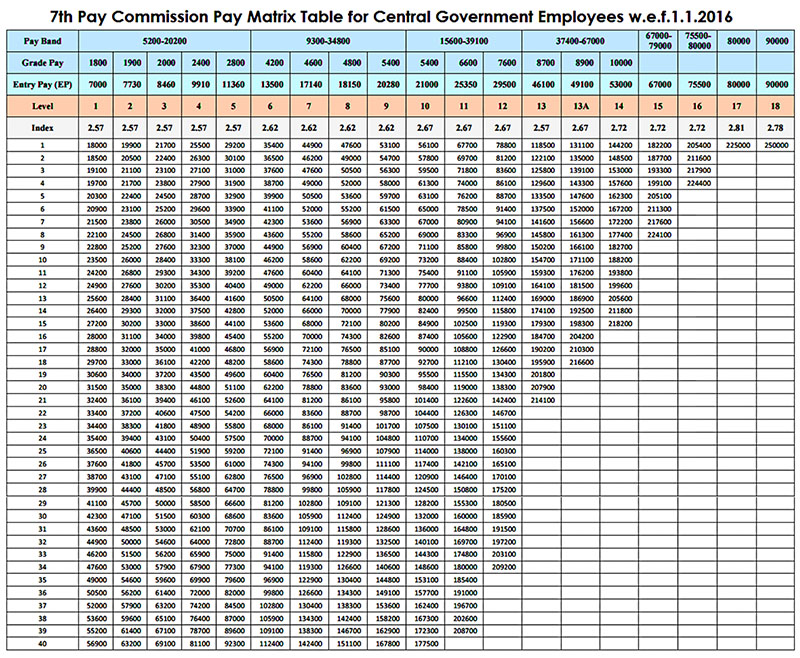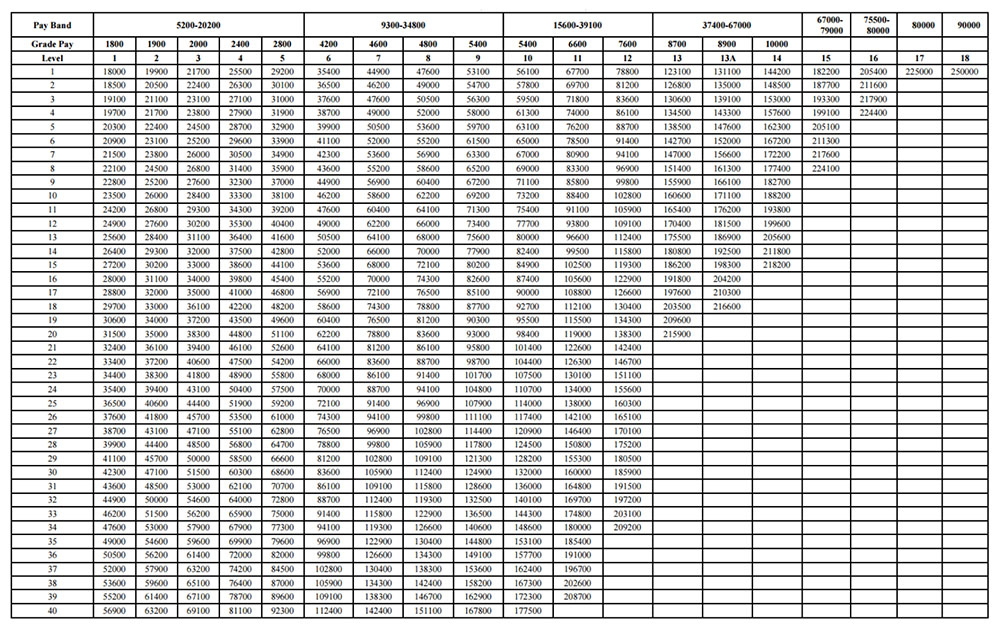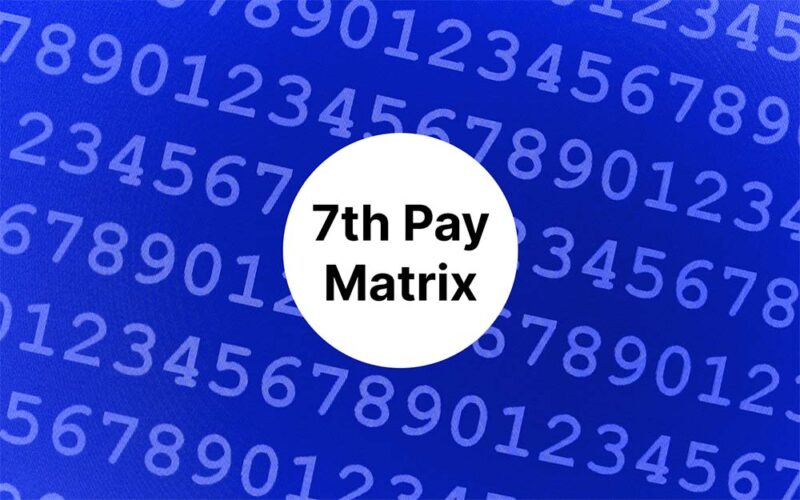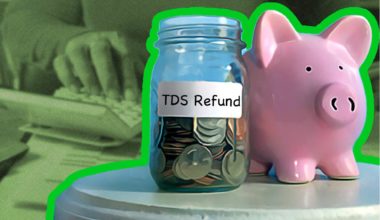Difference Between 7th Pay Commission and 7th Pay Matrix:
The 7th Pay Commission is a group appointed by the Indian government to suggest changes to the salary structure and benefits for government employees. They consider factors like inflation and the needs of the employees when making their recommendations.
The 7th Pay Matrix, on the other hand, is a system introduced by the 7th Pay Commission to organize and classify government employees. It assigns each employee a specific pay level based on their grade pay. This pay level determines their salary and allowances.
In simple terms, the 7th Pay Commission makes recommendations on employee salaries, while the 7th Pay Matrix is a system that determines the pay levels of government employees based on their grade pay.
The 7th Pay Matrix, implemented by the Indian government, is a comprehensive and standardized pay structure that plays a vital role in determining the salaries and allowances of central government employees. In this blog, we will provide you with an in-depth overview of the recent updates made to the pay matrix table, focusing on the benefits that come along with these revisions.
What is a Pay Commission?
A pay commission is a government-appointed body that reviews and recommends changes to the salary structure and allowances for government employees. The pay commission is typically established every few years to assess and revise the pay scales of central government employees. The recommendations made by the pay commission are based on various factors such as inflation, economic conditions, prevailing market rates, and the financial capacity of the government. The objective of the pay commission is to ensure fair and equitable compensation for government employees while considering the overall fiscal implications for the government.
Note: The Pay Commission is part of the Department of Expenditure, which is under the Ministry of Finance. It is not compulsory for the government to agree with the recommendations made by the Pay Commission. The government has the choice to accept or reject the recommendations as they see fit.
What is the 7th Pay Commission?
The 7th Pay Commission refers to a government-appointed body in India responsible for examining and recommending changes to the salary structure and allowances of central government employees. It was established on 28th February 2014 and submitted its report on 19th November 2015.
The 7th Pay Commission in India was led by Justice A.K. Mathur, who served as the Chairman of the commission. The other members of the commission were Vivek Rae, Dr. Rathin Roy, and Meena Agarwal.
The findings and recommendations of the 7th Pay Commission included several key aspects:
- Increase in Minimum Pay: The commission recommended an increase in the minimum pay from ₹7,000 to ₹18,000 per month.
- Fitment Factor: The commission proposed a fitment factor of 2.57, which would be used to calculate the revised pay for employees across different levels.
- House Rent Allowance (HRA): The commission revised the rates of HRA based on the classification of cities into three categories – X, Y, and Z. This ensured that employees received appropriate allowances based on the cost of living in their respective cities.
- Allowances: Various allowances, such as Dearness Allowance (DA), Transport Allowance, Children Education Allowance, and others, were rationalized and increased to provide better financial benefits to employees.
- Abolition of 53 Allowances: The commission recommended the abolition of 53 allowances and the merger of some others to simplify the allowances structure and reduce administrative complexities.
These findings and recommendations of the 7th Pay Commission were submitted to the government and subsequently accepted with certain modifications. The revised pay scales, allowances, and pension schemes were implemented for central government employees from 1st January 2016.
Since its implementation, the 7th Pay Commission has not made any major revisions or changes to the salary structure. However, it is important to note that the commission periodically reviews the pay scale and allowances to ensure they remain relevant and fair. These reviews can lead to modifications or updates in the future, depending on the economic conditions and the needs of government employees.
Important: Pay commissions in India are typically formed by the government when there is a need to review and recommend changes to the salary structure of central government employees and pensioners. The exact timing of when a pay commission is formed can vary based on various factors such as economic conditions, government policies, and the demands of government employees.
Historically, the formation of pay commissions has occurred at different intervals. For example, the 1st Pay Commission was formed in 1946, the 2nd in 1957, the 3rd in 1970, the 4th in 1983, the 5th in 1994, the 6th in 2006, and the 7th in 2013. It is important to note that the time gap between subsequent pay commissions is not fixed and can vary.
Overview of the 1st to 6th Pay Commissions
| Pay Commission | Time Period | Key Recommendations |
|---|---|---|
| 1st Pay Commission | 1946-1947 | Recommended minimum wage, allowances, and pension reforms. |
| 2nd Pay Commission | 1957-1959 | Introduced the concept of Dearness Allowance (DA) and revised pay scales. |
| 3rd Pay Commission | 1970-1973 | Recommended a significant increase in salaries and allowances. |
| 4th Pay Commission | 1983-1986 | Recommended reforms related to pay scales, allowances, and pension. |
| 5th Pay Commission | 1994-1997 | Recommended substantial salary hikes and allowances for government employees. |
| 6th Pay Commission | 2006-2008 | Introduced the concept of Pay Band and Grade Pay, implemented the Performance Related Incentive Scheme (PRIS). |
What is the 7th Pay Matrix?
The 7th Pay Matrix is a salary structure introduced by the 7th Pay Commission in India. The Pay Matrix is a grid-like structure that consists of 18 horizontal levels and 40 vertical stages. The horizontal levels represent various ranks or positions in the government hierarchy, while the vertical stages represent the annual increments or progressions within each level.
Each level in the Pay Matrix corresponds to a specific grade pay and has a corresponding minimum pay. The minimum pay in each level is determined based on the recommendations of the 7th Pay Commission and the revised fitment factor.
What is Fitment?
Fitment, in the context of the 7th Pay Commission in India, refers to the multiplication factor (2.57) used to calculate the revised pay of government employees. It involves multiplying the existing pay scale and grade pay by the fitment factor to determine the new pay in the revised salary structure. This factor takes into account various economic factors and ensures fairness and consistency in determining salaries.
For example, if an employee has a basic pay of ₹10,000 and a grade pay of ₹2,400, the revised pay would be calculated as follows:
Revised Pay = (Existing Pay + Grade Pay) x Fitment Factor
= (₹10,000 + ₹2,400) x 2.57
= ₹12,400 x 2.57
= ₹31,828
Therefore, the employee’s revised pay, based on the recommended fitment factor of 2.57, would be ₹31,828.
The Pay Matrix provides a transparent and consistent framework for determining salaries, as it takes into account both the employee’s position in the hierarchy and their length of service. The annual increments or progressions within each level allow for salary growth over time.
The Pay Matrix calculates the revised pay of central government employees based on their pay scale, grade pay, and length of service. It ensures a standardized and uniform approach to salary determination and provides employees with a clear understanding of their pay progression and potential growth within the government system.
Yes, the 7th Pay Commission is specifically implemented for government employees in India. It is a central government initiative aimed at revising the salary structure and allowances of employees working in various government departments, ministries, and organizations. The recommendations of the 7th Pay Commission are applicable to employees of the central government, including civil servants, defence personnel, and paramilitary forces. The implementation of pay commission recommendations for state government employees is determined by respective state governments.

Key Highlights of 7th Pay Matrix
Here are the key highlights of the Seventh Pay Commission in India:
- Recommended minimum pay for government employees: The 7th Pay Commission based on Aykroyd formula* suggests that newly hired government employees should receive a minimum monthly salary of Rs.18,000, compared to the previous Rs.7,000.
*The Aykroyd formula considers price changes in essential goods, helping determine the impact of inflation on the purchasing power of employees. It can be used as a reference to calculate salary hikes based on both employee performance and rising prices of necessary items, ensuring fair compensation and maintaining a reasonable standard of living.
- Recommended maximum pay for government employees: The Seventh Pay Commission also recommends increasing the maximum pay for government employees to Rs.2.25 lakhs per month for Apex Scale and Rs.2.5 lakhs per month for Cabinet Secretary and others at the same level.
- Fitment: To ensure fairness, the 7th Pay Commission recommends a uniform Fitment Factor of 2.57 for all employees.
- Annual increment: The Pay Commission suggests retaining the current annual increment of 3% per year.
- Dearness Allowance (DA): The Union Cabinet recently approved a 2% hike in Dearness Allowance, benefiting Central Government employees, pensioners, and staff members.
- Pay Matrix: The 7th Pay Commission suggests a new pay matrix to replace the existing Grade Pay Structure. This new system will determine a government employee’s status based on their level in the Pay Matrix, rather than their Grade Pay.
- Modified Assured Career Progression (MACP): The 7th Pay Commission aims to improve services by focusing on individual performance. MACP performance benchmarks have been made stricter, with the addition of a “Very good” performance level. Employees not meeting their performance level may not receive annual increments, and promotions may be affected if MACP is low for the first 20 years of service.
- Military Service pay (MSP): MSP will be paid to Defense Personnel only, as recommended by the Seventh Pay Commission.
- New Pay Structure: The recommended pay structure by the 7th Pay Commission includes all existing levels without introducing any new ones.
- Allowances: The Cabinet has reviewed and abolished certain allowances while retaining others.
- House Rent Allowance (HRA): The 7th Pay Commission proposes a 24% increase in House Rent Allowance. HRA will further increase based on the Dearness Allowance percentage.
- Medical changes: The 7th Pay Commission recommends a Health Insurance Scheme and cashless medical benefits for Central Government employees and pensioners.
- Pension: The Commission proposes a new pension formula for retired civil employees and military personnel. The pension amount will be determined based on the new Pay Matrix and the number of increments earned during active service.
- Gratuity: The Commission recommends increasing the ceiling on gratuity from Rs.10 lakh to Rs.20 lakh.
- Central Government Employees Group Insurance Scheme (CGEGIS): The Pay Commission has made changes to the CGEGIS rates based on the employee’s level.
- Disability Pension for Armed Forces: The Commission suggests implementing a slab-based system for disability element instead of the current percentile-based regime.
- Work Related Illness and Injury Leave (WRIIL): The Pay Commission recommends that employees hospitalized due to work-related illness or injury should receive full pay and allowances.
- Military Service pay (MSP): MSP will be paid to Defense Personnel only, as recommended by the Seventh Pay Commission.
- Advances: Non-interest-bearing advances, except Personal Computer Advance and House Building Advance, have been abolished.
How to Calculate Salary in 7th Pay Commission?
To calculate the salary in the 7th Pay Commission for central government employees, you need to consider the following components:
- Basic Salary: It is the main part of the salary and is crucial for calculation.
- Dearness Allowance (DA): It is an allowance that is revised periodically to account for inflation.
- House Rent Allowance (HRA): It is an allowance provided to cover accommodation expenses.
- Travel Allowance (TA): It is an allowance given to cover travel expenses.
- Other Allowances: Various other allowances may be applicable based on eligibility.
To calculate the gross monthly salary, add up the following components:
Gross Monthly Salary = Basic Salary + Dearness Allowance + House Rent Allowance + Travel Allowance + Other Allowances + Incentives (if applicable)
Let’s calculate the salary in the 7th Pay Commission for a central government employee with the following details:
Basic Salary: Rs 30,000
Dearness Allowance (DA): 12% of Basic Salary
House Rent Allowance (HRA): 20% of Basic Salary
Travel Allowance (TA): Rs 2,500
Other Allowances: Rs 4,000
To calculate the gross monthly salary, we’ll add up the following components:
Gross Monthly Salary = Basic Salary + Dearness Allowance + House Rent Allowance + Travel Allowance + Other Allowances
- Basic Salary: Rs 30,000
- Dearness Allowance (DA): 12% of Basic Salary
DA = 12/100 * Rs 30,000 = Rs 3,600 - House Rent Allowance (HRA): 20% of Basic Salary
HRA = 20/100 * Rs 30,000 = Rs 6,000 - Travel Allowance (TA): Rs 2,500
- Other Allowances: Rs 4,000
Now, let’s add up all the components:
Gross Monthly Salary = Rs 30,000 + Rs 3,600 + Rs 6,000 + Rs 2,500 + Rs 4,000 = Rs 46,100.
Therefore, the gross monthly salary for this central government employee in the 7th Pay Commission would be Rs 46,100.
Note: This is a simplified example and the actual calculation may involve additional factors and allowances specific to each employee. It is recommended to refer to the official guidelines and notifications for accurate calculations.
Overview of the 7th Pay Matrix Table

Disclaimer: Nothing on this blog constitutes investment advice, performance data or any recommendation that any security, portfolio of securities, investment product, transaction or investment strategy is suitable for any specific person. You should not use this blog to make financial decisions. We highly recommended you seek professional advice from someone who is authorised to provide investment advice.
What is basic pay scale?
What is the pay level structure?
What is India’s 7th Pay Commission Salary Structure?
- The structure consists of 18 levels, ranging from level 1 to level 18.
- The minimum pay at level 1 is Rs. 18,000 per month, while the maximum pay at level 18 is Rs. 2,50,000 per month.










